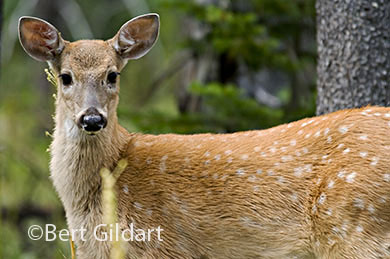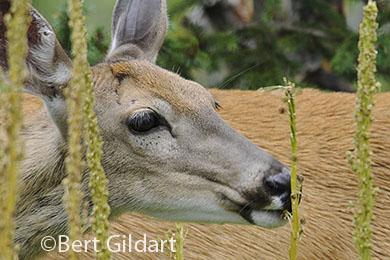Bear Grass–One Fawn’s Gourmet Meal

Vanishing spots
©Bert Gildart: White-tailed deer are now losing their spots, yet another sign of fall. This fawn was photographed in the Many Glacier Valley of Glacier National Park, and together with the second image posted here, show something else that’s interesting. The second photo proves that although bears may not be wild about bear grass, young deer can sure scarf it down.
Though Janie and I had discovered the deer on our own, a naturalists wandering along the trail near the Swift Current Motor Inn also had his eye on it. The man was part of the park’s new Watchable Wildlife program, intended to help visitors find wildlife and and to then help them understand and appreciate it.
THE PALATABLE BEAR GRASS SEEDS
“Guess there’s no question about it,” chuckled Bob Schuster, a park naturalist for over 30 years. “Deer sure do like those bear-grass seeds.”
Bob was a man I’d met previously, for once I had served as a ranger in the park. Bob, however, outstayed me by about 17 years. To make the Glacier position work for him he alternated his summer naturalist job with a career as a winter-time teacher. It’s a path many choose.
The Watchable Wildlife program has been very well received and several days later we joined a group watching bears on the side of Mount Altyn. Though many others are involved in the program, again we bumped into Schuster. He said that rangers and bear managers believe there are about a dozen bears that frequent the slopes of Altyn. Now, with the service berries growing so lush and juicy there may soon be more.

Bear grass seeds are gourmet food
“It’s one of their favorite food items,” said Schuster. “Studies in Alaska suggest they may eat thousands in the course of a single day. We can’t say that happens here as there have been no studies, but service berries sure are thick.”
That’s something Janie and I could confirm from all the bear scat we’d seen while hiking the trails, for in some cases their dropping seemed to consist of the dark-purple service berries and nothing else.
PHOTO TECHNIQUES
Photographs of the deer were taken with a Nikon’s D-300 Camera and an 80-400mm Nikon lens featuring image stabilization. Both images are full framed and not cropped, generally my practice. Because I shoot in the “Raw” format, that means file sizes are immense, large enough for a magazines to create two-page spread from them, something that occasionally happens. What’s more I shoot in the 16-bit mode, recommended for those who may want to do some manipulation in PhotoShop. After changes, I reduce the file to one that is 8-bits.
At the time I photographed the fawn, skies were overcast creating a soft light that works best in deep forest situations. In bright sun, shadows can be so intense you often need a strobe to soften the dark areas. Conversely, when shooting with the lens zoomed out to 400 as I did in the close-up shot, camera shake can often create blur. For tack-sharp photographs, image-stabilization is vital.
ABOUT THIS TIME ONE & TWO YEARS AGO:
AMAZON AD ABOUT MY CAMERA. CLICK AND BUY IT AND I GET A PERCENTAGE. IT’S HAPPENED!
ADS FROM SUCH INTERNET GIANTS AS AMAZON & GOOGLE HELP JANIE AND ME TRAVEL MORE. NOW THAT’S WORTHY OF SOME PHILANTHROPY–IS IT NOT?


July 26th, 2010 at 7:27 am
While we’re dabbling in the area of Bear Grass–a Gourmet Food For Deer | Bert Gildart: Writer and Photographer, Herbs have many uses, so making your own herb garden is a great way to add spice to your cooking – literally.